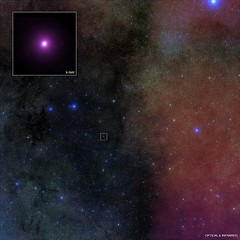
Erratic Black Hole...(NASA, Chandra, 03/25/09) Originally uploaded by nasa1fan
New results from NASA's Chandra X-ray Observatory have made a major advance in explaining how a special class of black holes may shut off the high-speed jets they produce. The results suggest that these black holes have a mechanism for regulating the rate at which they grow. The study looks at a famous micro-quasar in the Milky Way galaxy and regions close to its event horizon -- the point of no return.
Black holes come in many sizes: the supermassive ones, including those in quasars, which weigh in at millions to billions of times the mass of the Sun, and the much smaller stellar-mass black holes which have measured masses in the range of about 7 to 25 times the Sun's mass. Some stellar-mass black holes launch powerful jets of particles and radiation, like seen in quasars, and are called "micro-quasars".
The new study looks at a famous micro-quasar in our own Galaxy, and regions close to its event horizon, or point of no return. This system, GRS 1915+105 (GRS 1915 for short), contains a black hole about 14 times the mass of the Sun that is feeding off material from a nearby companion star. As the material swirls toward the black hole, an accretion disk forms.
This system shows remarkably unpredictable and complicated variability ranging from timescales of seconds to months, including 14 different patterns of variation. These variations are caused by a poorly understood connection between the disk and the radio jet seen in GRS 1915.
Chandra, with its spectrograph, has observed GRS 1915 eleven times since its launch in 1999. These studies reveal that the jet in GRS 1915 may be periodically choked off when a hot wind, seen in X-rays, is driven off the accretion disk around the black hole. The wind is believed to shut down the jet by depriving it of matter that would have otherwise fueled it. Conversely, once the wind dies down, the jet can re-emerge.
Image credit: X-ray: NASA/CXC/Harvard/J. Neilsen et al. Optical: Palomar DSS2
Read more/see larger images:
www.nasa.gov/mission_pages/chandra/multimedia/photo09-020...
Learn more about Chandra:
www.nasa.gov/chandra
p.s. You can see all of our Chandra photos in the Chandra Group in Flickr at: www.flickr.com/groups/chandranasa/ We'd love to have you as a member!

0 comments:
Post a Comment